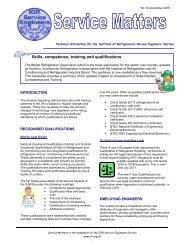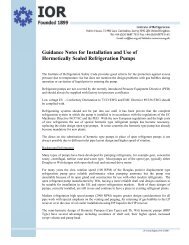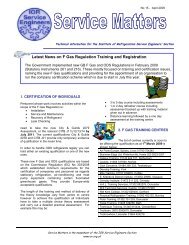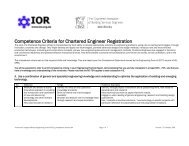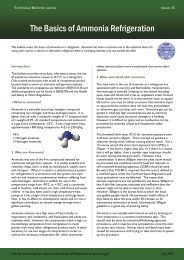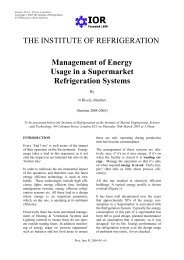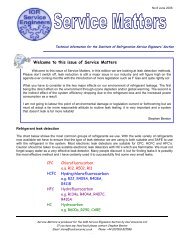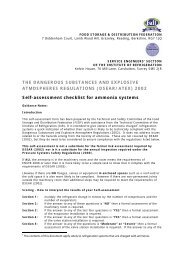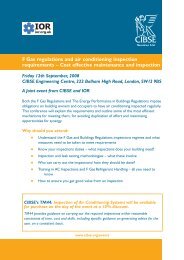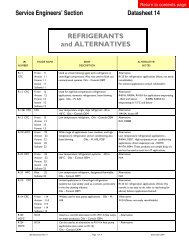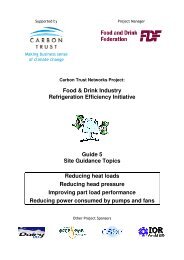Ammonia systems self assessment checklist for DSEAR - Institute of ...
Ammonia systems self assessment checklist for DSEAR - Institute of ...
Ammonia systems self assessment checklist for DSEAR - Institute of ...
You also want an ePaper? Increase the reach of your titles
YUMPU automatically turns print PDFs into web optimized ePapers that Google loves.
FOOD STORAGE & DISTRIBUTION FEDERATION7 Diddenham Court, Lamb Wood Hill, Grazeley, Reading, Berkshire. RG7 1JQINSTITUTE OF REFRIGERATIONKelvin House, 76 Mill Lane, Carshalton, Surrey SM5 2JRTHE DANGEROUS SUBSTANCES AND EXPLOSIVEATMOSPHERES REGULATIONS (<strong>DSEAR</strong>/ATEX) 2002Self-<strong>assessment</strong> <strong>checklist</strong> <strong>for</strong> ammonia <strong>systems</strong>Guidance Notes:IntroductionThis <strong>self</strong>-<strong>assessment</strong> <strong>for</strong>m has been prepared by the Technical and Safety Committee <strong>of</strong> the FoodStorage and Distribution Federation (FSDF) with assistance from the Technical Committee <strong>of</strong> the<strong>Institute</strong> <strong>of</strong> Refrigeration (IoR). It is intended to give owners <strong>of</strong> ammonia charged 1 refrigeration<strong>systems</strong> a quick indication <strong>of</strong> whether their system is likely to be technically compliant with theDangerous Substances and Explosive Atmosphere Regulations (2002). It does not address issuesrelated to or the hazards arising from the toxicity <strong>of</strong> ammonia. These are not covered by <strong>DSEAR</strong>(2002), but they do need to be considered to ensure compliance with the regulations listed below.This <strong>self</strong>-<strong>assessment</strong> is not a substitute <strong>for</strong> the <strong>for</strong>mal risk <strong>assessment</strong> required by<strong>DSEAR</strong> (2002) nor is it a substitute <strong>for</strong> the annual inspection required under thePressure Systems Safety Regulations (2000).If ALL the ammonia is in the machinery room and the room meets the requirements <strong>of</strong>EN378:2008 or later then it is more likely to be a simple task to show that it complies with therequirements <strong>of</strong> <strong>DSEAR</strong> (2002).Likewise if there are NO flanges, valves or equipment in enclosed spaces such as a ro<strong>of</strong> void orthe cold space it is also more likely to be compliant. However if there are non-permanent jointsoutside the machinery room then additional steps may be required to meet the requirements <strong>of</strong><strong>DSEAR</strong> (2002).Scoring - How to interpret the results <strong>of</strong> your Self-<strong>assessment</strong>Section 1:Section 2:Section 3:Section 4:Section 5:multiply the refrigerant charge in tonnes by the number <strong>of</strong> compressors and thenumber <strong>of</strong> evaporatorsif the answer to any <strong>of</strong> these questions is “NO” then a <strong>for</strong>mal <strong>assessment</strong> <strong>of</strong> themachinery room is required.if the answer to any <strong>of</strong> the last four questions is “YES” then a <strong>for</strong>mal <strong>assessment</strong><strong>of</strong> the evaporator installation is required.if the answer to any <strong>of</strong> the last four questions is “YES” then a <strong>for</strong>mal <strong>assessment</strong><strong>of</strong> the valve station installation is required.if the answer to any <strong>of</strong> the questions is “Moderate” or “Severe” then a <strong>for</strong>mal<strong>assessment</strong> <strong>of</strong> the valve station installation is required. If the answer to any <strong>of</strong> thequestions is “Slight” and the score in Section 1 is greater than 20 then a <strong>for</strong>mal<strong>assessment</strong> <strong>of</strong> the valve station installation is recommended.1 The contents <strong>of</strong> this document apply solely to refrigeration <strong>systems</strong> that are charged with ammonia.
<strong>DSEAR</strong> Self-<strong>assessment</strong> <strong>checklist</strong> <strong>for</strong> ammonia <strong>systems</strong>Revised: February 2013Possible cost impactSection 2: if the answer to any <strong>of</strong> these questions is “NO” then the cost <strong>of</strong> compliance may besignificant.Section 3&4: If however, the answer to all <strong>of</strong> the first three questions in Section 3 and Section 4is “YES” then compliance costs are likely to be low.In addition to <strong>DSEAR</strong> (2002) this guidance <strong>for</strong> ammonia <strong>systems</strong> is set out against a background <strong>of</strong>legislation in <strong>for</strong>ce in the UK at the time <strong>of</strong> its publication. These include <strong>for</strong> example:* Environmental Protection Act (1990)* Health and Safety at Work etc. Act (1974)* Construction (Design and Management) Regulations (2007)* Control <strong>of</strong> Substances Hazardous to Health Regulations (2002)* Electricity at Work Regulations (1989)* Management <strong>of</strong> Health and Safety at Work Regulations (1999)* Regulatory Re<strong>for</strong>m (Fire Safety) Order (2005)* Pressure Systems (Safety) Regulations (2000)It is there<strong>for</strong>e recommended that an <strong>Ammonia</strong> Hazard Study & Risk Assessment as required by<strong>DSEAR</strong> (2002) and the Management <strong>of</strong> Health & Safety at Work Regulations (1999) and otherrelevant legislation should be covered in one document.When must the <strong>DSEAR</strong>/ATEX workplace requirements be met?In areas where dangerous quantities and concentrations <strong>of</strong> flammable ammonia gas or vapourmay arise, protective measures must be applied in order to reduce the risk <strong>of</strong> explosions in orderto comply with <strong>DSEAR</strong> (2002).The specific <strong>DSEAR</strong> (2002) requirements dealing with explosive atmospheres come into effect atdifferent times depending on when the equipment (or system) is first used. The exact dates areas follows: All equipment in use be<strong>for</strong>e July 2003 must be compliant with <strong>DSEAR</strong> (2002) by July 2006 Equipment installed be<strong>for</strong>e July 2003 that has been modified be<strong>for</strong>e July 2006 must becompliant from the time the modification was carried out All equipment installed after June 2003 must be compliant from the time it comes into useHazardous Area ClassificationThe International Standard IEC 60079 Part 10-1: Classification <strong>of</strong> areas – Explosive gasatmospheres sets out the essential criteria against which the ignition hazards can be assessed, andgives guidance on the design and control parameters which can be used in order to reduce such ahazard.The FSDF guidance document HAZARDOUS AREA CLASSIFICATION OF REFRIGERATIONPLANTS USING AMMONIA (R717) AS THE REFRIGERANT 2 complements IEC 60079-10-1as it provides detailed requirements <strong>for</strong> hazardous area classification <strong>of</strong> permanent andtemporary refrigeration plants using ammonia as the refrigerant charge.© 2013 FSDF & IoR - All Rights ReservedFebruary 20132 Copies <strong>of</strong> all FSDF Technical Bulletins, Guides and all other publications are available to members free <strong>of</strong>charge. There can also be purchased by others direct from the FSDF subject to payment <strong>of</strong> the appropriatefee.© Copyright 2012 – All Rights Reserved Page | 2
<strong>DSEAR</strong> Self-<strong>assessment</strong> <strong>checklist</strong> <strong>for</strong> ammonia <strong>systems</strong>Revised: February 2013System NameLocationAssessed by: Date: DD/MM/YY1. System In<strong>for</strong>mationType <strong>of</strong> System Cold Store Chill Store Production OtherOriginal date <strong>of</strong> installation DD/MM/YY Date <strong>of</strong> last major modification DD/MM/YYTotal system charge Kgs Number <strong>of</strong> compressorsNumber <strong>of</strong> pumpsDefrost TypeNumber <strong>of</strong> evaporatorsNumber <strong>of</strong> condensers2. Machinery Room<strong>Ammonia</strong> detection system YES NO Date <strong>of</strong> last calibration DD/MM/YYEmergency Ventilation YES NO Date <strong>of</strong> last functional check DD/MM/YYVentilators correctly sited YES NO Date <strong>of</strong> last functional check DD/MM/YYRelief Lines vent outside room YES NO PRV Discharge in low risk area YES NOSeparate Electrical Room YES NO Electrical Room Pressurised YES NOAutomatic electrical breaker YES NO No Sources <strong>of</strong> ignition in room YES NO3. Evaporators<strong>Ammonia</strong> detection system YES NO Date <strong>of</strong> last calibration DD/MM/YYEmergency Ventilation YES NO Date <strong>of</strong> last functional check DD/MM/YYAutomatic electrical breaker YES NO Date <strong>of</strong> last functional check DD/MM/YYFlanges in room YES NO Mechanical equipment in room YES NOValves in room (inc. solenoids) YES NO Strainers/Drains in room YES NO© Copyright 2012 – All Rights Reserved Page | 3
<strong>DSEAR</strong> Self-<strong>assessment</strong> <strong>checklist</strong> <strong>for</strong> ammonia <strong>systems</strong>Revised: February 20134. Valve StationsIndoor or outdoor OUT IN In store or ro<strong>of</strong> void Store/Void<strong>Ammonia</strong> detection system YES NO Date <strong>of</strong> last calibration DD/MM/YYEmergency Ventilation YES NO Date <strong>of</strong> last functional check DD/MM/YYAutomatic electrical breaker YES NO Date <strong>of</strong> last functional check DD/MM/YYFlanges in room NO YES Mechanical equipment in room NO YESValves in room (inc solenoids) NO YES Strainers/Drains in room NO YES5. Physical ConditionIs there rust on exposed pipe None Slight Moderate SevereIs there ice on insulated pipe None Slight Moderate Severe<strong>Ammonia</strong> smell in machinery room None Slight Moderate SevereLeaks around liquid pumps None Slight Moderate Severe<strong>Ammonia</strong> smell in ro<strong>of</strong> void None Slight Moderate Severe<strong>Ammonia</strong> smell at evaporators None Slight Moderate SevereAny banging/knocking during defrost None Slight Moderate SevereDescribe any instances <strong>of</strong> rust or icethat have been assessed as moderateor severe. Use additional pages ifnecessary. Treat each instanceseparately so that their repair can bescheduled and confirmed.Recommended date <strong>for</strong> next <strong>assessment</strong> DD/MM/YY Signed:© Copyright 2012 – All Rights Reserved Page | 4



